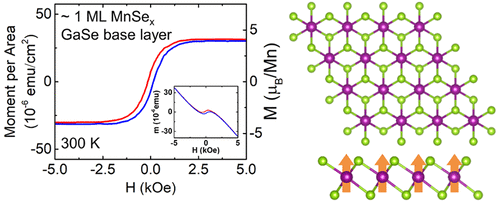当前位置:
X-MOL 学术
›
Nano Lett.
›
论文详情
Our official English website, www.x-mol.net, welcomes your feedback! (Note: you will need to create a separate account there.)
Room Temperature Intrinsic Ferromagnetism in Epitaxial Manganese Selenide Films in the Monolayer Limit
Nano Letters ( IF 10.8 ) Pub Date : 2018-04-02 00:00:00 , DOI: 10.1021/acs.nanolett.8b00683 Dante J. O’Hara 1 , Tiancong Zhu 2 , Amanda H. Trout 3, 4 , Adam S. Ahmed 2 , Yunqiu Kelly Luo 2 , Choong Hee Lee 5 , Mark R. Brenner 5, 6 , Siddharth Rajan 4, 5 , Jay A. Gupta 2 , David W. McComb 3, 4 , Roland K. Kawakami 1, 2
Nano Letters ( IF 10.8 ) Pub Date : 2018-04-02 00:00:00 , DOI: 10.1021/acs.nanolett.8b00683 Dante J. O’Hara 1 , Tiancong Zhu 2 , Amanda H. Trout 3, 4 , Adam S. Ahmed 2 , Yunqiu Kelly Luo 2 , Choong Hee Lee 5 , Mark R. Brenner 5, 6 , Siddharth Rajan 4, 5 , Jay A. Gupta 2 , David W. McComb 3, 4 , Roland K. Kawakami 1, 2
Affiliation

|
Monolayer van der Waals (vdW) magnets provide an exciting opportunity for exploring two-dimensional (2D) magnetism for scientific and technological advances, but the intrinsic ferromagnetism has only been observed at low temperatures. Here, we report the observation of room temperature ferromagnetism in manganese selenide (MnSex) films grown by molecular beam epitaxy (MBE). Magnetic and structural characterization provides strong evidence that, in the monolayer limit, the ferromagnetism originates from a vdW manganese diselenide (MnSe2) monolayer, while for thicker films it could originate from a combination of vdW MnSe2 and/or interfacial magnetism of α-MnSe(111). Magnetization measurements of monolayer MnSex films on GaSe and SnSe2 epilayers show ferromagnetic ordering with a large saturation magnetization of ∼4 Bohr magnetons per Mn, which is consistent with the density functional theory calculations predicting ferromagnetism in monolayer 1T-MnSe2. Growing MnSex films on GaSe up to a high thickness (∼40 nm) produces α-MnSe(111) and an enhanced magnetic moment (∼2×) compared to the monolayer MnSex samples. Detailed structural characterization by scanning transmission electron microscopy (STEM), scanning tunneling microscopy (STM), and reflection high energy electron diffraction (RHEED) reveals an abrupt and clean interface between GaSe(0001) and α-MnSe(111). In particular, the structure measured by STEM is consistent with the presence of a MnSe2 monolayer at the interface. These results hold promise for potential applications in energy efficient information storage and processing.
中文翻译:

单层极限条件下外延硒化锰薄膜的室温本征铁磁性
单层范德华(vdW)磁体为探索二维(2D)磁性技术的科学发展提供了令人兴奋的机会,但是固有的铁磁性仅在低温下才能观察到。在这里,我们报告观察到的分子束外延(MBE)生长的硒化锰(MnSe x)薄膜中的室温铁磁性。磁性和结构表征提供了有力的证据,表明在单层范围内,铁磁性源自vdW二硒化锰(MnSe 2)单层,而对于较厚的薄膜,它可能源自vdW MnSe 2和/或α-的界面磁性MnSe(111)。GaSe和SnSe上单层MnSe x薄膜的磁化测量2个外延层显示出铁磁有序,其饱和磁化强度为每Mn约4 Bohr磁子,这与预测单层1T-MnSe 2中铁磁性的密度泛函理论计算是一致的。与单层MnSe x样品相比,在GaSe上生长MnSe x膜直至达到高厚度(〜40 nm)都会产生α-MnSe(111)和增强的磁矩(〜2x)。通过扫描透射电子显微镜(STEM),扫描隧道显微镜(STM)和反射高能电子衍射(RHEED)进行的详细结构表征揭示了GaSe(0001)和α-MnSe(111)之间的突变界面。特别地,通过STEM测量的结构与MnSe 2的存在相一致。界面上的单层。这些结果为在节能信息存储和处理中的潜在应用提供了希望。
更新日期:2018-04-02
中文翻译:

单层极限条件下外延硒化锰薄膜的室温本征铁磁性
单层范德华(vdW)磁体为探索二维(2D)磁性技术的科学发展提供了令人兴奋的机会,但是固有的铁磁性仅在低温下才能观察到。在这里,我们报告观察到的分子束外延(MBE)生长的硒化锰(MnSe x)薄膜中的室温铁磁性。磁性和结构表征提供了有力的证据,表明在单层范围内,铁磁性源自vdW二硒化锰(MnSe 2)单层,而对于较厚的薄膜,它可能源自vdW MnSe 2和/或α-的界面磁性MnSe(111)。GaSe和SnSe上单层MnSe x薄膜的磁化测量2个外延层显示出铁磁有序,其饱和磁化强度为每Mn约4 Bohr磁子,这与预测单层1T-MnSe 2中铁磁性的密度泛函理论计算是一致的。与单层MnSe x样品相比,在GaSe上生长MnSe x膜直至达到高厚度(〜40 nm)都会产生α-MnSe(111)和增强的磁矩(〜2x)。通过扫描透射电子显微镜(STEM),扫描隧道显微镜(STM)和反射高能电子衍射(RHEED)进行的详细结构表征揭示了GaSe(0001)和α-MnSe(111)之间的突变界面。特别地,通过STEM测量的结构与MnSe 2的存在相一致。界面上的单层。这些结果为在节能信息存储和处理中的潜在应用提供了希望。



























 京公网安备 11010802027423号
京公网安备 11010802027423号